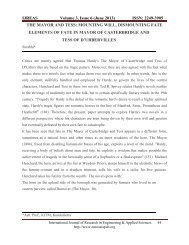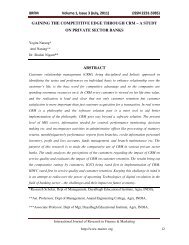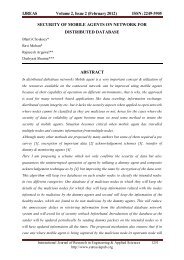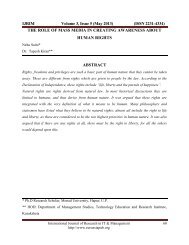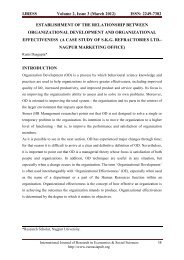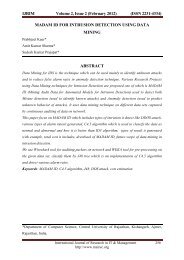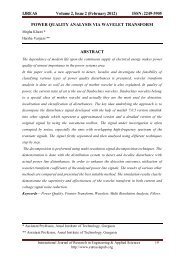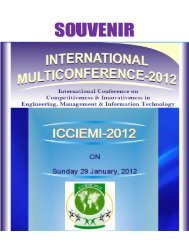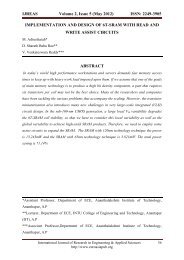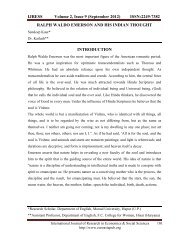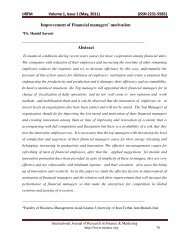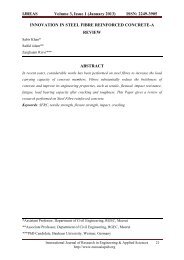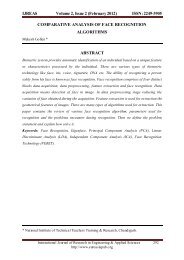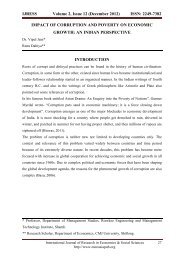study on the growth and yield of mushroom white ... - Euroasiapub.org
study on the growth and yield of mushroom white ... - Euroasiapub.org
study on the growth and yield of mushroom white ... - Euroasiapub.org
Create successful ePaper yourself
Turn your PDF publications into a flip-book with our unique Google optimized e-Paper software.
IJREAS Volume 2, Issue 4 (April 2012) ISSN: 2249-3905OBJECTIVESKeeping in view <strong>the</strong> extensive applicati<strong>on</strong>s <strong>of</strong> enzymes, <strong>the</strong> proposed research work has beentaken up with following objectives:1. To assess <strong>the</strong> enzymatic producti<strong>on</strong> under in vivo c<strong>on</strong>diti<strong>on</strong> at different stages <strong>of</strong><strong>growth</strong> <strong>of</strong> Pleurotus species during cultivati<strong>on</strong>.2. The ultimate aim <strong>of</strong> <strong>the</strong>se studies is to get enhanced producti<strong>on</strong> <strong>of</strong> extracellularenzymes.REVIEW OF LITERATUREPleurotus, a basidiomycetes:Fungi secrete enzymes which play a role in <strong>the</strong> degradati<strong>on</strong> <strong>of</strong> lignocelluloses material <strong>and</strong>o<strong>the</strong>r recalcitrant materials. Various elements (i.e. carb<strong>on</strong>, nitrogen, hydrogen, oxygen,potassium, phosphorus etc.) present in <strong>the</strong> substrates are released by <strong>the</strong> enzymatic hydrolyticactivity <strong>of</strong> <strong>the</strong> micro<strong>org</strong>anism <strong>and</strong> are used in <strong>the</strong>ir food chain leading to <strong>the</strong>ir fur<strong>the</strong>rmultiplicati<strong>on</strong>. Lignocelluloses wastes degradati<strong>on</strong> maintains envir<strong>on</strong>mental <strong>and</strong> nutriti<strong>on</strong>albalance in ecosystem (Eveleigh, 1987). Lignocelluloses materials serve as substrate forfur<strong>the</strong>r fermentati<strong>on</strong> to fuels <strong>and</strong> chemicals.Cellulolytic enzymes have gained great importance in recent past in view <strong>of</strong> <strong>the</strong>ir role indegradati<strong>on</strong> <strong>of</strong> lignocelluloses (Erikss<strong>on</strong>, 1993; Ortega et al., 1993; Singh <strong>and</strong> Kaushal,1996). Numerous micro<strong>org</strong>anisms produce celluloses in nature, <strong>of</strong> which fungi have been <strong>the</strong>most studied (Erikss<strong>on</strong>, 1993). Cellulose acts <strong>on</strong> cellulose which is <strong>the</strong> first most abundantsingle <strong>org</strong>anic compound in biosphere followed by lignin In nature, cellulose is alwaysassociated with variety <strong>of</strong> hemicelluloses al<strong>on</strong>g with phenolic polymers e.g. lignin. Am<strong>on</strong>g<strong>the</strong> micro<strong>org</strong>anisms studied so far <strong>the</strong>re is a complete set <strong>of</strong> hydrolytic (cellulolytic) enzymesminimally composed <strong>of</strong> following enzymes involved in cellulose degradati<strong>on</strong>.MATERIAL AND METHODSpawn is a <strong>white</strong> fibrous matter that forms <strong>the</strong> matrix when fungus grow <strong>and</strong> is referred to as<strong>the</strong> vegetative mycelium <strong>of</strong> <strong>the</strong> fungus, which is grown <strong>on</strong> cereal grains i.e,grains <strong>of</strong> barley,maize, bajra, wheat, rice, oat etc. The preparati<strong>on</strong> <strong>of</strong> spawn is d<strong>on</strong>e by soaking <strong>of</strong> buffers.After sterilizati<strong>on</strong>, inoculati<strong>on</strong> with pure culture <strong>of</strong> appropriate Pleurotus app. under asepticc<strong>on</strong>diti<strong>on</strong>s. For preparati<strong>on</strong> <strong>of</strong> spawn, 500 ml <strong>of</strong> dextose bottles or polypropylene bags wereused. The fungal mycelium started spreading <strong>on</strong> <strong>the</strong> grains after 3 to 4 days, <strong>and</strong> appear like<strong>white</strong> net web. In 10-12 days <strong>the</strong> bottles <strong>on</strong> bags were half filled <strong>and</strong> it took 18-20 days for<strong>the</strong> bottles to be completely filled with <strong>white</strong> mycelium <strong>growth</strong>.Internati<strong>on</strong>al Journal <strong>of</strong> Research in Engineering & Applied Sciences 39http://www.euroasiapub.<strong>org</strong>



